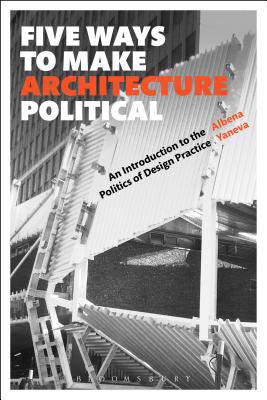
- Afhalen na 1 uur in een winkel met voorraad
- Gratis thuislevering in België vanaf € 30
- Ruim aanbod met 7 miljoen producten
- Afhalen na 1 uur in een winkel met voorraad
- Gratis thuislevering in België vanaf € 30
- Ruim aanbod met 7 miljoen producten
Zoeken
Five Ways to Make Architecture Political
An Introduction to the Politics of Design Practice
Albena Yaneva
Hardcover | Engels
€ 203,95
+ 407 punten
Uitvoering
Omschrijving
Five Ways to Make Architecture Political presents an innovative pragmatist agenda that will inspire new thinking about the politics of design and architectural practice.
Moving beyond conventional conversations about design and politics, the book shows how recent developments in political philosophy can transform our understanding of the role of designers. Introducing the framework of contemporary post-foundational politics in a way that is accessible to designers, it asks: how, when, and under what circumstances can design practice generate political relations? How can architectural design become more 'political'?
Five central chapters, which can be read alone or in sequence, explore the answers to these questions. Powerfully pragmatic in approach, each presents one of the 'five ways to make architecture political', and each is illustrated by case studies from a range of contemporary situations around the world. We see how politics happens in architectural practice, learn how different design technologies have political effects, and follow how architects reach different publics, trigger reactions and affect different communities worldwide.
Combining an accessible introduction to contemporary political concepts with a practical approach for a more political kind of practice, this book will stimulate debate among students and theorists alike, and inspire action in established and start-up practices.
Moving beyond conventional conversations about design and politics, the book shows how recent developments in political philosophy can transform our understanding of the role of designers. Introducing the framework of contemporary post-foundational politics in a way that is accessible to designers, it asks: how, when, and under what circumstances can design practice generate political relations? How can architectural design become more 'political'?
Five central chapters, which can be read alone or in sequence, explore the answers to these questions. Powerfully pragmatic in approach, each presents one of the 'five ways to make architecture political', and each is illustrated by case studies from a range of contemporary situations around the world. We see how politics happens in architectural practice, learn how different design technologies have political effects, and follow how architects reach different publics, trigger reactions and affect different communities worldwide.
Combining an accessible introduction to contemporary political concepts with a practical approach for a more political kind of practice, this book will stimulate debate among students and theorists alike, and inspire action in established and start-up practices.
Specificaties
Betrokkenen
- Auteur(s):
- Uitgeverij:
Inhoud
- Aantal bladzijden:
- 200
- Taal:
- Engels
Eigenschappen
- Productcode (EAN):
- 9781474252355
- Verschijningsdatum:
- 18/05/2017
- Uitvoering:
- Hardcover
- Formaat:
- Genaaid
- Afmetingen:
- 155 mm x 236 mm
- Gewicht:
- 476 g

Alleen bij Standaard Boekhandel
+ 407 punten op je klantenkaart van Standaard Boekhandel
Beoordelingen
We publiceren alleen reviews die voldoen aan de voorwaarden voor reviews. Bekijk onze voorwaarden voor reviews.








